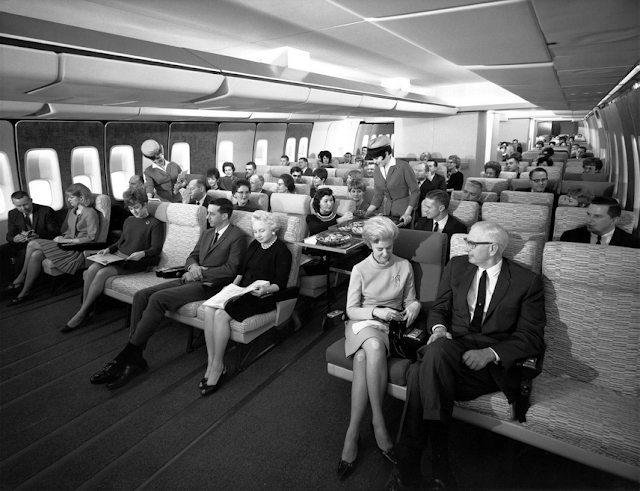(Sigh!)

This was ECONOMY class - note the air travelers "uniform"
Posted on 08/22/2016 11:57:32 AM PDT by djf
Airbus killed the idea of making a 380F. It would have had 25% less payload than a 747F.

The 747 is not simply going away. It will be around a long time, even if not exactly the same as 1969.
As for fewer engines...as someone declared, having more options is safer. 4 is better than 2 for recovery or continuation.
Watching “Air disasters” can really change one’s perpective, if not personal experience!
Seriously?
Airframe less expensive, fuel costs far less expensive, maintenence far less expensive. Range . . . same.
Pilot preference . . . Except for some of the grey hairs stuck in the past, pilots will take a B787 in a nano-second
Passenger comfort?? Depends on where you sit as with any airplane
Cherish the past, look to future
The argument over four engines versus two has been settled in favor of two -- provided that the two are robust and reliable newer model engines, and in an aircraft with modern fly by wire computer control systems that can smoothly adjust for the loss of a single engine.
The loss of both engines is another matter. When that happens, as when US Airways Flight 1549 ditched in the Hudson without loss of life, it helps to have a supremely capable pilot in command.
A 747 can fly with two engines out, but a first rate flight crew had better be aboard -- and you should prefer that it is one of the later models with a computerized glass cockpit.
If not, that flight crew will be hard pressed to work an older 747's essentially mechanical (if hydraulically assisted) flight controls and keep watch on its banks of old style gauges. For that reason, older 747s require a flight crew of three, as opposed to the two needed for modern twin engine airliners -- a potent consideration in favor of such twins for cost-paring airline operators.
Those were the days,my friend,we thought they’d never end.
:-)
.
Simply from a stability standpoint, 1 engine gone on a 2-engine leaves one side rather unstable. Whereas on a 4-engine, ther is still 1 on that side to continue. Much more stable by nature.
The 2-engine is understandable from economy standpoint, but everything else being the same, it simply is mechanically unstable if just 1 goes out of 2.
The Boeing 787 and 777 are thus certified for up to ETOPS-330, meaning that they can fly for 330 minutes (five and a half hours) on a single engine. The Airbus A330 is certified for 180 minutes of ETOPS flying, and the A350 is pending certification for 420 minutes of ETOPS.
“What other jumbo jet can fly from Sydney, AU to Dallas, TX?”
the 777 flies Los Angeles to Sydney daily. My Sis is a Flight attendant for Delta and has made that trip once a week for the last three years. That trip is 7500 miles which isnt as far as Dallas which is 8500 miles, but the 777 can stretch it to 9500 Miles.
Looks like even the 747 doesn't do that flight, only the Quantas A380 is running that route. He longest current commercial flight right now is Auckland to Dubai running a Triple 7 8800 miles.
Only if the new tech, and processes they spent money on, are only used for the 787, then I’d agree with you.
They made an investment in future manufacturing for new airframes.
...
Good point. But if they had to do the 787 over again, would they do it differently? Serious question. I don’t know the answer.
Aware of all the attempts at compensation, but simply stated, losing thrust on one whole side is mechanically unstable. At least with one engine still remaining on one side, there is some thrust created on same wing.
John Cox, a pilot and head of an aviation safety consultancy, says the ETOPS program actually has made long-distance flying safer overall. The twin jets that get this rating "are actually more robust than the earlier generation three- or four-engine airplanes," he says, and the latter can effectively operate without any restrictions on their distance from land. "We are now routinely flying over vast oceans with a better safety record."
But what if an engine does conk out? "Nobody likes losing an engine," Cox notes, no matter where they are, but this isn't the doomsday scenario most people assume. With the lower power generated by just one engine, the plane would go into what pilots call "driftdown", or flying at a lower altitude at slower speeds. As fuel burns off, the plane would be lighter and could ascend to higher altitudes. There are few routes in the world where the plane would be so far from an airport that it would need to take advantage of the maximum time allotted under the expanded ETOPS rules, he says.
So why (and how) does QANTAS QF8 use Airbus-380s on that route?
Yes, I now see that QANTAS QF8 uses Airbus-380 from DFW to Brisbane.
Again, previously (prior to 2015?) Qantas only used the 747 and they told me the 380 only had capacity to go LA to Brisbane & Sydney - DFW. So the 380 must have increased their capacity.
Disclaimer: Opinions posted on Free Republic are those of the individual posters and do not necessarily represent the opinion of Free Republic or its management. All materials posted herein are protected by copyright law and the exemption for fair use of copyrighted works.